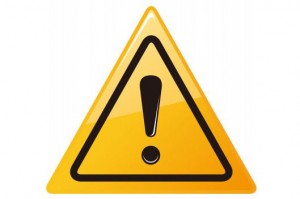Top Six Mistakes Once You Have Digital Signage
 OK, you’ve done your homework, strategizing and planning and making the best possible decisions to ensure your digital signage investment has the greatest chance for success. Now you just have to turn on the switch, sit back and let the content roll, right?
OK, you’ve done your homework, strategizing and planning and making the best possible decisions to ensure your digital signage investment has the greatest chance for success. Now you just have to turn on the switch, sit back and let the content roll, right?
Wrong!
In case no one told you, digital signage requires an ongoing commitment of time and resources, and the road ahead is fraught with as many potholes as the road you just traveled to get your system in place. So, to make your journey a little easier, let’s talk about the top mistakes we see people make after they’ve bought a digital signage system:
Trying to do too much on the screen. Your software comes with a lot of options, but you don’t need to show everything at once. Remember that your goal is to deliver information. Your message can get lost if you have your screen packed with so much that viewers can’t pick out the different things you’re telling them. You’re better off using different features at different times to keep drawing people in and keep them interested.
Letting messages get stale. If you’ve left something on your playlist too long because you forgot about it, chances are your audience has, too. Keep it fresh by showing new content every day, and show things more often for shorter time periods versus running one thing on the screen all day long. New content is what keeps your audience coming back.
Not updating your software. In addition to keeping content fresh, you need to keep your content management software fresh as well. New software features will let you do more with your messages more efficiently. And don’t forget that you may need to update hardware once in a while, too.
Using audio where you shouldn’t. In public areas like lobbies, lounges or cafeterias, you may want to use audio on your screens for videos or TV channels you’re piping in. But if you’re running something with audio somewhere that people are working and need to concentrate — especially if it repeats a lot — you may end up annoying your audience more than attracting them.
Forgetting the call to action. Everything you publish should prompt the viewer to do something — and they can’t do that unless you tell them how. So make sure your messages direct people to where they can get more information or take the action you want them to. This will also help you with measuring return on investment (ROI).
Not publishing policies. You’re always going to have new people who come on board and need to know how to use the system. So once you’ve had it up and running for a month or so, write down policies and put them somewhere that everyone can see them, like on a website. Quite simply, you need to have guidelines so everyone’s on the same page about what they can and can’t do with your digital signage.
As marketing communications manager for Atlanta-based Visix Inc., Debbie DeWitt handles all of the company’s marketing and communications campaigns, including branding, advertising, newsletters, sales tools, web and event planning. She’s been with the company since 2004 and has more than 20 years of experience in the digital signage and audiovisual industries. Visix Inc. designs, develops and supports a suite of browser-based digital signage products that allows users to create, manage and schedule organizational communications from anywhere and to deliver messages and media to virtually any endpoint.
The company offers digital signage software, interactive wayfinding, meeting room signs and applications for targeted messaging to desktops and portable devices. For information related to the content of this article, you can contact DeWitt at marketing@visix.com.
This article was reprinted with permission from the Digital Signage Connection and originally appeared here.


